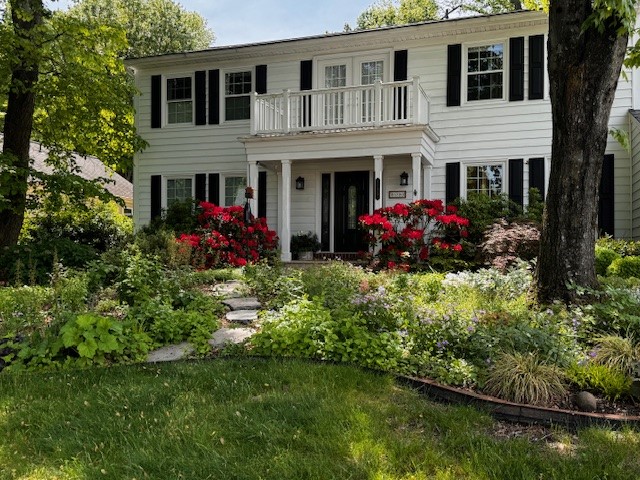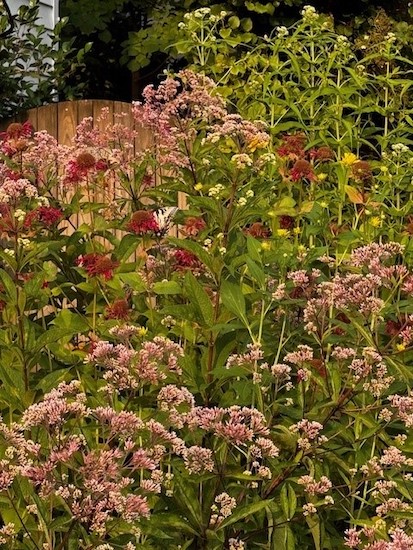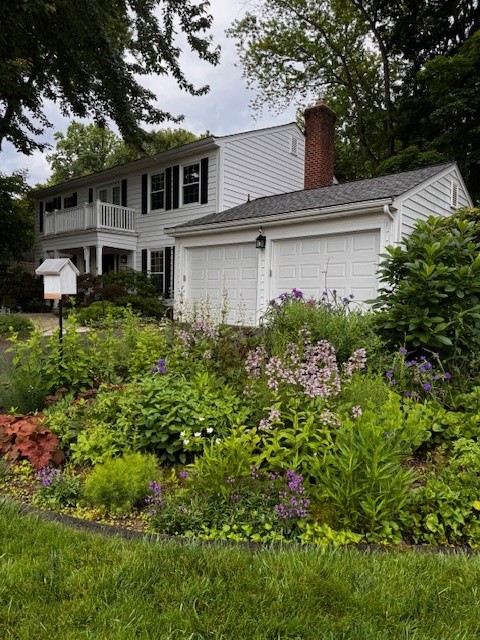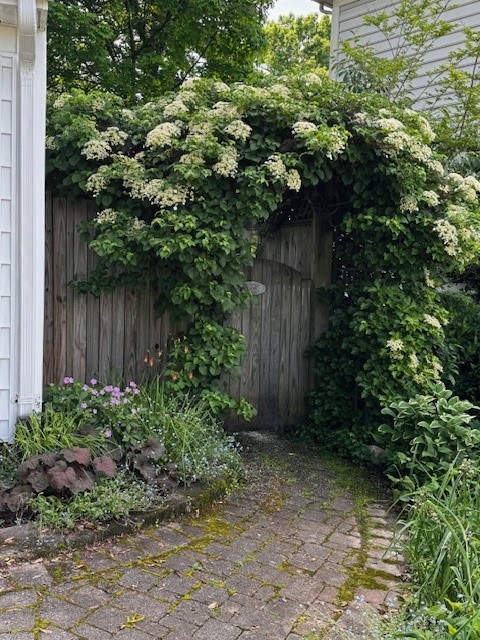An Open Garden Tour of Native Plants
by Sylvia Sloan, Fairfax Master Gardener
 Master Gardener Kate Dando was inspired when she heard Doug Tallamy speak about being more environmentally friendly by having native plants in your yard. Kate looked around her yard and realized she had work to do to meet Tallamy’s target of 70 percent native plants. She had a lot of mature foundation plants that she loved, Rhododendron, Pieris, Boxwood (Buxus) and a dwarf Japanese maple (Acer palmatum) and hated to replace them. What were her options?
Master Gardener Kate Dando was inspired when she heard Doug Tallamy speak about being more environmentally friendly by having native plants in your yard. Kate looked around her yard and realized she had work to do to meet Tallamy’s target of 70 percent native plants. She had a lot of mature foundation plants that she loved, Rhododendron, Pieris, Boxwood (Buxus) and a dwarf Japanese maple (Acer palmatum) and hated to replace them. What were her options?
Kate knew she had some invasive plants in her yard, including English Ivy, Pachysandra, and Vinca. She knew it would be best to eliminate these and replace them with native plants. First to go was the English Ivy. Sometimes removing invasives is an on-going battle; she is still working on the Pachysandra and Vinca. You may be aware that some invasives are difficult to irradicate, especially if widespread. Doug Tallamy, on his Homegrown National Park webpage, has some good advice on eliminating invasives.
Kate researched which were the best pollinator plants for her area (sun/shade and moist/dry). She wanted native plants that would bloom in the spring, summer and fall and wanted to follow the standard design principles for plant placement. She observed that many of the plants that bloom in the spring are lower to the ground, and many are ephemerals, perennials which die back after blooming. She chose green and gold (Chrysogonum virginianum), woodland phlox (Phlox divaricata) and creeping phlox (Phlox stolonifera) as well as alumroot (Heuchera americana), a type of coral bells, as the foundation for her spring blooming plants. Many of the plants that bloom in summer such as Black-eyed Susan (Rudbeckia hirta), Bee Balm (Monarda) and Indian Pink (Spigelia marilandica) are tall enough to cover the spring-blooming ephemerals, such as Spring Beauty (Claytonia virginiana). Fall blooming plants, such as New York Iron Weed (Vernonia noveboracensis) and Joe-Pye Weed (Eutrochium purpureum), are often even taller. Knowing this helped her determine placement of her plants.

Joe Pye Weed and Coneflower
Kate looked around her yard and decided to begin by replacing some of her grass with native plants. She started by creating a small bed around a large tree. The next year she enlarged that bed and also planted a rain garden. There are numerous native plants that love the shade cast by her tree and even tolerate the dry conditions created by the tree, absorbing much of the available water. There are also many native plants that are well adapted to the flood/drought cycle of a rain garden in both sun and shade. There are numerous websites that help identify these plants such as Plant NOVA Natives. Over several years, the rain garden grew larger as she added more plants. Then, she lost a large oak and what was once a shady area became sunny. Some plants were relocated. Hostas were replaced with rain garden loving plants such as Golden Seal (Packera aurea) and red and blue lobelia (Lobelia cardinalis and Lobelia siphilitica). Kate focused on perennials for her beds. They come back every year, reducing costs and labor by not having to replace annuals every year.
To keep her front yard neat and tidy, Kate focused on low growing and evergreen plants, such as the Heuchera, green and gold and phloxes. According to Kate, some Rudbeckia varieties are able to be tamed, and the basal stems make a very neat and tidy evergreen ground cover. In order to reduce maintenance requirements, Kate used ground covers in place of mulch. This reduces the amount of weeding and keeps the ground cooler in summer. She likes low growing plants and ground covers next to paths and walkways, keeping them neat and easy to use and maintain. Golden Seal, the phloxes and the green and gold are evergreen, and the Coral Bells are semi-evergreen.
 What advice does Kate have for anyone who would like to make their yard more environmentally friendly? Start small. Choose the area that you’re interested in redeveloping and determine if it’s sunny, shady, dry or moist. Begin with a bed around a tree or a border along the edge of a path or drive or make an interestingly shaped bed in your yard. The beds can be widened gradually. If you don’t have a tree, you can plant one. Deciduous trees on the south and west side of your house can reduce cooling costs 20 to 40 percent. Don’t be afraid to move plants around if they are not happy where they are first planted.
What advice does Kate have for anyone who would like to make their yard more environmentally friendly? Start small. Choose the area that you’re interested in redeveloping and determine if it’s sunny, shady, dry or moist. Begin with a bed around a tree or a border along the edge of a path or drive or make an interestingly shaped bed in your yard. The beds can be widened gradually. If you don’t have a tree, you can plant one. Deciduous trees on the south and west side of your house can reduce cooling costs 20 to 40 percent. Don’t be afraid to move plants around if they are not happy where they are first planted.
Tallamy has said that we should think of our lawn as an oriental carpet, with beds and plantings surrounding or bordering it, that include native species that provide food and habitat for pollinators and other wildlife. To help the climate, plant shrubs and trees that will absorb and store more carbon. Shrinking your lawn may save you both money and time by reducing chemicals you may be adding to your lawn and reducing mowing.
Native plants are also quite happy with a layer of leaf litter, so you don’t have to rake leaves up and bag them. Leave them in place to provide winter protection for your plants and the pollinators. According to Penn State College of Agriculture, leaf litter is teaming with life. Microbes get to work, breaking down the organic matter into smaller and smaller pieces which can then be consumed and excreted by a number of organisms. Many species of insects found in leaf litter are pollinators including butterflies and moths. If you would like to increase biodiversity in your yard, ceasing to rake leaves is an easy and effective practice to adopt. Nurturing insect life under the leaves will support a wide variety of springtime plants and animals. Virtually all songbirds require insects, specifically caterpillars, to feed their young. You may even attract small amphibians such as toads and salamanders that live under moist leaves and eat insects.
 One other thing Kate has discovered is an easy environmentally friendly way to control mosquitos. Fill a bucket with water and add plant material, such as grass. Let it ferment for about three days to attract egg-laying mosquitoes. At this point, add a mosquito dunk and this will kill the larvae, eliminating the next generation of mosquitoes. It’s a good idea to add a stick so frogs or small insects can find their way out if they fall in. Kate found that this greatly reduced the mosquitos in her yard.
One other thing Kate has discovered is an easy environmentally friendly way to control mosquitos. Fill a bucket with water and add plant material, such as grass. Let it ferment for about three days to attract egg-laying mosquitoes. At this point, add a mosquito dunk and this will kill the larvae, eliminating the next generation of mosquitoes. It’s a good idea to add a stick so frogs or small insects can find their way out if they fall in. Kate found that this greatly reduced the mosquitos in her yard.
What’s next for Kate? She and her family have purchased 25 acres in New Hampshire and are building a home there. So far, she has found one invasive on her land. She is planning to create a 20′ x 30′ border garden of native plants. Given the size and scope of what she wants to do, she will need some design help. She will start small this time as well, adding plants over time.
Kate said she’d be happy to work with anyone interested in adding natives to their yard. You can contact her through the Master Gardener Help Desk or through a local plant clinic.
Many thanks to Kate Dando for her contributions to this article and for sharing her garden with us.
-
References
- Insect Life Under the Leaves, Heather Desorcie, Pennsylvania State University, College ofAgricultural Sciences
- Earth Sangha Native Plant Compendium
- Plant Northern Virginia (NOVA) Natives
- The Living Landscape by Richard Darke and Doug Tallamy
- Nature’s Best Hope by Doug Tallamy